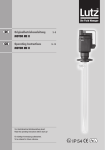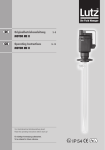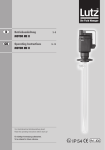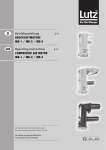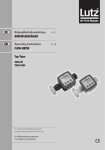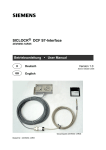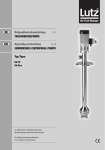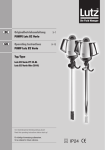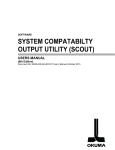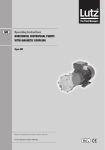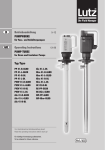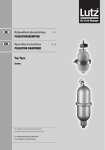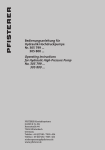Download Originalbetriebsanleitung ZapfpistOlEn Operating instructions
Transcript
DE DE Originalbetriebsanleitung Zapfpistolen 2–4 GB Operating Instructions Nozzles 5–7 Typ/Type PP PVDF Niro/SS Messing/Brass Alu Vor Inbetriebnahme Betriebsanleitung lesen! Read this operating instructions before start up! Für künftige Verwendung aufbewahren. To be retained for future reference. DE Bestimmungsgemäße Verwendung Allgemeine Sicherheitshinweise Die Betriebsanleitung ist vor Inbetriebnahme vom Bediener zu lesen und die Hinweise sind während des Betriebs einzuhalten. 1. Richten Sie die Zapfpistole nicht auf Personen. 2. Der Bediener hat beim Abfüllen gefährlicher Flüssigkeiten (z.B. ätzend, heiß, giftig usw.) passende Schutzkleidung zu tragen, Gesichtsmaske oder Schutzbrille, Schürze und Handschuhe. 3. Beachten Sie, dass alle Anschlüsse und Verbindungen richtig befestigt sind. 4. Beachten Sie die Grenzwerte für Temperatur, Viskosität und Dichte der Förderflüssigkeit. 5. Verwenden Sie die Zapfpistole nicht zum Abfüllen von festen oder abrasiven Stoffen. 6. Prüfen Sie die Beständigkeit der Zapfpistole gegen das Fördermedium. Die Zapfpistole ist ein handbetätigtes Ventil zur Regulierung der Durchflussmenge. Durch feinfühliges Betätigen des Ventilhebels kann die Durchflussmenge verändert werden. Die Zapfpistolen der Typen PP und PVDF dienen zum Ab- und Umfüllen neutraler und aggressiver Flüssigkeiten. Die Zapfpistole des Typs Niro dient zum Ab- und Umfüllen von Flüssigkeiten im Bereich der Lebensmittel- und pharmazeutischen Industrie sowie brennbarer, leicht entzündlicher Flüssigkeiten. Bei der Zapfpistole Niro befindet sich am Einlass ein Drehgelenk. Dieses ermöglicht bei steifen Schlauchleitungen das Verdrehen der Zapfpistole in die gewünschte Auslaufrichtung. Technische Daten Gefahr! Das Überschreiten der Grenzen für Druck, Viskosität, Durchfluss und Flüssigkeitstemperatur, sowie der Einsatz ungeeigneter Flüssigkeiten beschädigt die Zapfpistole. Spritzende Flüssigkeit oder wegfliegende Teile können Sie verletzen oder töten. Halten Sie die Werte in der nachfolgenden Tabelle ein. Prüfen Sie anhand einer Beständigkeitstabelle (z.B. Lutz-Beständigkeitstabelle), ob die Zapfpistole für die Flüssigkeit geeignet ist: Die Einstufung brennbarer Flüssigkeiten erfolgt nach Richtlinie 67/548/EWG. Beim Fördern brennbarer Flüssigkeiten sind die Betriebssicherheitsverordnung und die nachfolgenden Punkte zu beachten: 1. Setzen Sie nur die Zapfpistole Typ Niro oder Messing ein. 2. Verwenden Sie ausschließlich leitfähige Schlauchleitungen und leitfähige Schlaucheinbindungen. 3. Stellen Sie einen Potentialausgleich für das gesamte Leitungssystem und eine Verbindung zum Erdpotential her. Die Unfallverhütungsvorschriften des jeweiligen Landes sind unbedingt einzuhalten. Typ Max. Betriebsdruck bei 20°C Max. Viskosität Max. Durchfluss (Wasser) Flüssigkeitstemperatur Gewicht ca. Anschluss Dichtung PP (G 1 1/4) 3 bar PP (DN 19) 1 bar PVDF 3 bar Niro 3 bar Messing 4 bar Alu 4 bar 760 mPas 50 l/min 300 mPas 40 l/min 760 mPas 50 l/min 760 mPas 50 l/min 760 mPas 80 l/min 760 mPas 60 l/min 0 – 50°C 0,25 kg G 1 1/4 (außen) FPM (Viton)® EPDM FEP/Viton® 0 – 50°C 0,1 kg DN 19 0 - 80 °C 0,3 kg G 1 1/4 (außen) FPM (Viton)® 0 - 80 °C 1 kg G 1 1/4 (außen) FPM (Viton)® FEP/Viton® 0 - 80 °C 0,6 kg G 1 1/4 (außen) PTFE 0 - 60 °C 0,5 kg G 1 (innen) FPM (Viton)® Vitonh ist ein eingetragenes Warenzeichen von Du Pont Performance Elastomers NBR DE Einsatz für brennbaren Flüssigkeiten Gefahr! Brand- und Explosionsgefahr durch Förderflüssigkeit! Verbrennungsgefahr. Druckwelle: wegfliegende Teile können Sie töten. Halten Sie beim Fördern brennbarer Flüssigkeiten die geltenden Richtlinien für den Explosionsschutz ein. Montageanleitung für Zapfpistolen PP und PVDF mit Schlauchanschluss drehbar Benetzen Sie Gleitflächen und Dichtringe mit einem geeigneten Gleitmittel (Verträglichkeit mit Durchflussmedium beachten!). Vor Inbetriebnahme der Zapfpistole ist unbedingt der Potentialausgleich im System Pumpe - zu entleerendes Behältnis - zu befüllendes Behältnis - herzustellen. Eine leitfähige Verbindung zwischen zu entleerendem und zu füllendem Behältnis wird durch einen leitfähigen Untergrund (z.B. leitfähige Roste) sichergestellt. Ein gut leitfähiger Übergang zwischen Behältnis und Erdpotential muss ebenfalls vorhanden sein. PP Erklärung: (1) Potentialausgleichskabel, (2a) leitfähiger Untergrund oder Anschluss eines Potentialausgleichskabels an beiden Fässern, (2b) galvanische Verbindung (geringer Übergangswiderstand zur Erde), (3) leitfähiger Schlauch, (4) leitfähige Verbindung von Schlauch und Schlauchstecker, (5) Pumpwerk für Zone 0, (6) Motor mit nichtberührbaren Metallteilen, (7) Zapfpistole DE Reparaturen Rückverfolgbarkeit Es dürfen nur Original-Ersatzteile von Lutz Pumpen verwendet werden. Geräte der Firma Lutz Pumpen für explosionsgefährdete Bereiche sind an Hand einer individuellen Seriennummer gekennzeichnet, die der Rückverfolgbarkeit dient. Aus dieser Zahl können Baujahr und Geräteausführung bestimmt werden. Gefahr! Bei fehlender Befestigungsschraube am Schutzbügel fallen die 3 Kugeln aus dem Drehgelenk und die Zapfpistole wird undicht. Die Befestigungsschraube ist durch den Schutzbügel gegen Lösen gesichert. - Achten Sie bei Reparaturarbeiten darauf, dass am Drehgelenk immer 3 Kugeln eingebaut sind. - Tauschen Sie den Schutzbügel aus, wenn die Sicherungswirkung für die Befestigungsschraube nicht mehr ausreicht. Niro Gefahr! Beim Einsatz im explosionsgefährdeten Bereich oder beim Fördern brennbarer Flüssigkeiten ist nach Reparaturarbeiten und bei Wiederholungsprüfungen nach EN 12115 zu beachten: - Die Leitfähigkeit der Schlauchleitung ist zusammen mit der Zapfpistole zu überprüfen. - Das Drehgelenk muss während der Leitfähigkeitsprüfung in alle möglichen Positionen bewegt werden. Vor der Rücksendung des Gerätes müssen Sie folgendes beachten: •Rückstände im Gerät können die Umwelt und die menschliche Gesundheit gefährden. Entleeren Sie das Gerät vollständig, spülen und reinigen Sie es danach. •Teilen Sie uns mit, welche Flüssigkeit gefördert wurde. Fügen Sie der Lieferung ein entsprechendes Sicherheitsdatenblatt bei. Bei diesem Produkt handelt es sich um ein Gerät für explosionsgefährdete Bereiche. Diesbezüglich und unter Berücksichtigung der ATEX-Richtlinie 94/9/EG sind spezifische Vorkehrungen zu treffen, um die Rückverfolgbarkeit des Gerätes im vor- und nachgeschalteten Bereich sicherzustellen. Unser mit ATEX-Bescheid zertifiziertes QM-System gewährleistet diese Rückverfolgbarkeit bis zum Ort der ersten Auslieferung. Ausgenommen im Falle gegenteilig lautender vertraglicher Bestimmungen sind alle Personen, die diese Geräte weiterliefern, dazu verpflichtet, ein System einzuführen, das eine eventuell erforderliche Rückrufaktion für fehlerhafte Geräte ermöglicht. GB Proper use General safety information The operator must read the operating instructions before starting and follow these instructions during operation. 1. Do not point the nozzle at persons. 2. The operator must wear suitable protective clothing, face mask or goggles, apron and gloves when transferring hazardous liquids (e.g. caustic, hot, poisonous etc.). 3. Ensure that all connections and fittings are properly tightened. 4. Note the limit values for temperature, viscosity and density of the medium being pumped. 5. Do not use nozzle for filling solid or abrasive matters. 6. Ensure that the nozzle is resistant to the medium being transfered The classification of flammable liquids is made according to directive 67/548/EEC. When pumping flammable liquids the operational safety regulation and the following points have to be observed: 1. Only use nozzle type SS and brass. 2. Only use conductive hose lines and conductive hose connections. 3. Equipotenial bonding for the whole piping and a connection to earthing must be provided. The nozzle is a manually operated valve for regulating the flow quantity. The flow rate can be changed by pressing sensitively the valve lever. The nozzles of type PP and PVDF are used to fill and transfer neutral and aggressive liquids. The stainless steel nozzle is suitable for filling and transferring liquids of the food- and pharmaceutical industry as well as flammable and easy combustible liquids. The stainless steel nozzle inculdes a rotary joint on the inlet. This makes it possible to turn the nozzle in the desired direction with rigid hoses. Technical data Danger! The nozzle can be damaged when exceeding the limits for pressure, viscosity, flow and temperature of medium as well as handling unsuitable liquids. Splashing liquid or flying parts can cause injury or may kill you. Observe the values in the following table. Check that the nozzle materials are compatible with the medium being delivered (e.g. Lutz-catalogue resistance table): The national accident prevention regulations must be observed without fail. Type Max. operating pressure at 20°C Max. viscosity Max. flow (water) Temperature of liquid Weight approx. Connection Sealing PP (G 1 1/4) 3 bar PP (DN 19) 1 bar PVDF 3 bar SS 3 bar Brass 4 bar Alu 4 bar 760 mPas 50 l/min 0 – 50°C 0.25 kg G 1 1/4 (male) FPM (Viton)® EPDM FEP/Viton® 300 mPas 40 l/min 0 – 50°C 0.1 kg DN 19 760 mPas 50 l/min 0 - 80 °C 0.3 kg G 1 1/4 (male) FPM (Viton)® 760 mPas 50 l/min 0 - 80 °C 1 kg G 1 1/4 (male) FPM (Viton)® FEP/Viton® 760 mPas 80 l/min 0 - 80 °C 0.6 kg G 1 1/4 (male) PTFE 760 mPas 60 l/min 0 - 60 °C 0.5 kg G 1 (female) FPM (Viton)® NBR Vitonh is a registered trademark of DuPont Performance Elastomers. GB Application for flammable liquids Danger! Fire and explosion hazard due to delivered liquid! Combustion hazard. Blast wave: Flying parts can kill you. When handling flammable liquids the valid directives for explosion protection have to be observed. Assembly instruction for nozzles PP and PVDF with hose connection turnable Wet the sliding surfaces and seal ring with a suitable lubricant. (Ensure it is compatible with the flow medium!) Before starting up the nozzle, an equipotential bonding must be established between the pump, the container to be emptied and the container to be filled. The conductive connection between the full and empty containers is achieved by means of a conductive substrate (e.g. conductive gratings). The transition between container and earthing must also be conductive. Legend: (1) Equipotential bonding cable, (2a) Conductive substrate or connection of an equipotential bonding cable to each of the two drums, (2b) Galvanic connection (low contact resistance towards earth), (3) Conductive hose, (4) Conductive connection between hose and hose connector, (5) Zone 0 pump tube, (6) Motor with inaccessible metal parts, (7) Nozzle PP GB Repairs Traceability Only use original Lutz spare parts. Products manufactured by Lutz Pumpen for potentially explosive atmospheres are identified by an individual batch number which allows them to be traced. This number provides the year of construction and the design of the equipment. Danger! If the fastening screw for the protective clamp is missing, the 3 balls fall out of the rotary joint and the nozzle will not be properly sealed. The fastening screw is protected by the protective clamp from coming loose. - When making repair works, make sure that always 3 balls are attached at the rotary joint. - If the protection feature for the fastening screw is not satisfactory, the protective clamp must be replaced. This product is an appliance for potentially explosive atmospheres. In this regard and in compliance with the EC ATEX 94/9 Directive, provisions must be made to ensure ascending and desccending traceability. Our ATEX notified quality system ensures this traceability up to the initial point of delivery. Except as otherwise agreed in writing, anyone that guarantees to redeliver said equipment undertakes to put in place a system that allows for equipment that is not conform to be recalled if necessary. SS Danger!! After use in explosion hazard areas or when handling flammable liquids following has to be observed according to EN 12115 after repair works or repeated inspections: - Conductivity of the hose line must be checked along with the nozzle. - During the conductivity check the rotary joint must be moved into all possible positions. Before sending back the appliance, following must be observed: •Residuals in the appliance can cause danger to the environment and human health. The appliance must be completely emptied, rinsed and cleaned. •Please advise which liquid has been pumped. A respective safety data sheet must be attached to the return consignment. DE Lutz Pumpen GmbH Erlenstraße 5-7 D-97877 Wertheim Tel. (0 93 42) 8 79-0 Fax (0 93 42) 87 94 04 e-mail: [email protected] http://www.lutz-pumpen.de Technische Änderungen vorbehalten. 01/10 Subject to technical changes. Best.-Nr. 0698-070 Printed in Germany Mt. 1.000/06.10








